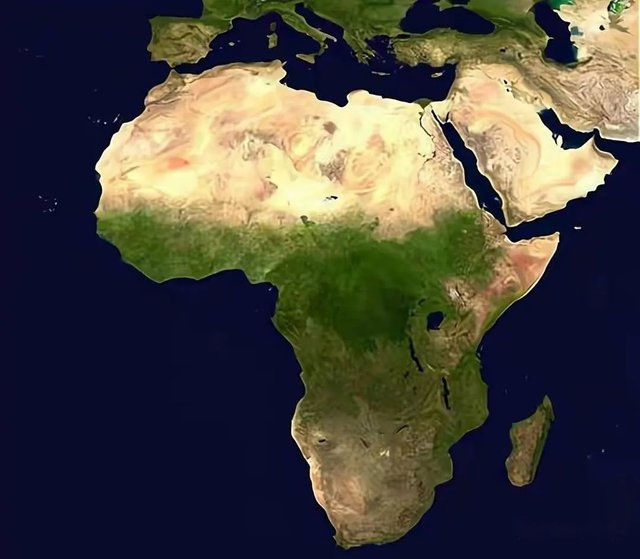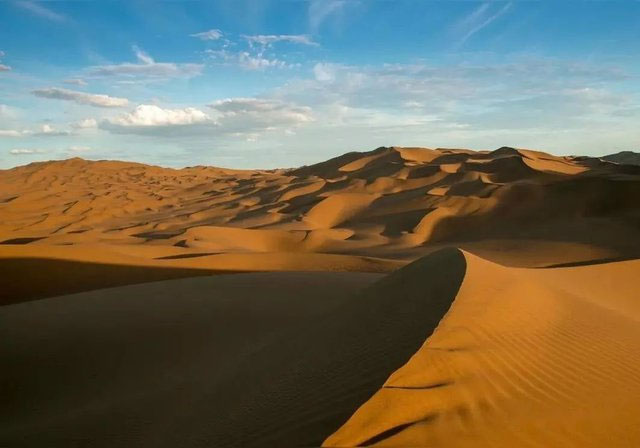What lies beneath the thick sands of the Sahara desert in Africa?
Currently, the world's desert area has reached 30 million square kilometers, accounting for 20% of the total land area. The Sahara Desert is the largest desert in the world, this desert passes through northern Africa, with a length of 5,600 km from east to west and about 1,600 km from north to south, a total area of more than 9 million square kilometers, covers about a third of the total area of Africa.
The natural environment in the Sahara is extremely harsh - dry, with little rain and extremely unfavorable for life to survive and is dubbed the 'second largest desert in the world', second only to Antarctica. Even now, when ordinary people cross the Sahara, if they are not well prepared, they will inevitably have to go through a near-death experience.

During the Ice Age, the Sahara was a lot wetter than it is today. And there used to be many species of animals and plants living here. Today, however, with the exception of the Nile valley where a lot of vegetables can be grown, and a few other places like the northern highlands, near the Mediterranean, where olive trees can be grown, most of this area cannot be cultivated. can work.
When a large area of land is in an extremely dry state for a long time, lacking vegetation and water, after a long time will form deserts, rocky deserts, gravel deserts (Gobi) and other deserts. other deserts. Sand in the desert is formed by the process of desertification of soil and weathering of rocks. That means, no matter how big the desert, there is certainly a limit to the thickness of the sand layer.
The thickness of the desert sand layer is related to the time of formation, topography, direction and local wind speed. Deserts in different places have different thicknesses of sand layers, even in the same desert, the thickness of sand layers in different locations is also different. Usually the edge of the desert is where the sand is thinnest. According to statistics, the average thickness of the world's deserts is about 3.5 meters.

The Sahara Desert covers most of North Africa, stretching to 12 countries: Algeria, Chad, Egypt, Libya, Mali, Morocco, Eritrea, Sudan, Tunisia, Western Sahara, Niger. Since 1962, the Sahara desert has expanded by nearly 650,000 square kilometers.
So how thick is the sand in the Sahara? What's under the sand?
To know how thick the desert sands are and what's under the sand, some might think we can discover this by drilling and digging deep into the desert, but there's another, more efficient, advanced way. much more advanced and precise.
Electromagnetic waves have the ability to penetrate geological layers, and any substance has different characteristics of reflecting or radiating electromagnetic waves. This means we can use electromagnetic waves to detect the bottom of the desert.

In fact, the depth of the desert depends on other factors such as the time of formation, topography, direction and force of the wind. In areas with a lot of dunes, the depth of the sand also changes with the movement of the sand.
This technology is called remote sensing technology, born in the 1960s. First, the detection system by satellite, aircraft, . is used to transmit electromagnetic waves of specific frequency to the sa desert, then the spectral features of the reflected electromagnetic waves will be analyzed to identify geological features. After studying and processing the collected data, we can get information such as the thickness of the sand layer in the desert. The application of this technology is very wide, such as exploring mineral resources in the ground, measuring ice thickness, mapping seabed topography.

From the collected data, scientists found that the average depth of the Sahara desert is about 150 m, equivalent to the height of a 50-story building (calculated by the height of the floor is 3m).
According to remote sensing data, the lowest thickness of the Sahara desert sand is about 3.6 meters, and the thickest point is up to 320 meters.
In fact, not all of the Sahara Desert is sandy, the surface covered with sand is mainly located in the central and northern regions, while the surface of most other areas is exposed rock and gravel. .
In addition to the existence of oil in the Sahara, there are still many ancient river and lake ruins under the sand of the Sahara. According to geologists' estimates, one of the giant lakes, at its height, was 108,000 square kilometers and 247 meters deep.
These findings mean that long ago, the Sahara was not a desert, but a verdant paradise with vegetation and water, nurturing many species of flora and fauna.
As for why this area turned into a desert, scientists believe it has something to do with plate motion. Between 7 and 11 million years ago, the shrinking of the Tethys Sea (ancient Mediterranean Sea) led to a significant weakening of the North African summer monsoon, eventually gradually turning the ancient Sahara into a desert.
In fact, whether it's a desert, ocean, or other topographical feature, if you remove water, sediment, etc. and dig deep underground, you'll eventually encounter hard rocks. If we could dig up all the sand in the Sahara, what would be exposed would be hard rock.
Earth is a rocky planet. Excluding the atmosphere and hydrosphere, the Earth can be divided into three layers: the crust, the mantle, and the core from the outside to the inside. The upper atmospheric part of the mantle and the entire crust belong to the lithosphere. The entire lithosphere is about 60 to 120 km thick, and the crust of the land is thicker than the ocean, but this is still less than 2% of the Earth's radius.
- Many deserts ... water
- Little known facts about the Sahara desert
- Explore the mysterious ancient citadel in the Sahara desert
- The wild world on the Sahara desert
- Found the true age of the Sahara desert?
- The Sahara is submerged under a meter of snow
- Could it be that humans have turned the Sahara into a desert?
- The world's largest solar power project in Sahara
- The mystery of the Sahara jungle
- Using radar to measure the depth of the Sahara desert, scientists discovered a giant 'thing' below
- Li explained the white snow phenomenon in the Sahara desert
- Sahara wildlife is getting less and less
 The most famous scientific failures in history
The most famous scientific failures in history Mysterious genius mechanic and the machine froze time
Mysterious genius mechanic and the machine froze time The son carries the 'bad gene' of genius Albert Einstein
The son carries the 'bad gene' of genius Albert Einstein Isaac Newton
Isaac Newton How did experts build a railway in the 'deadly' desert using 2 tons of paper to create blueprints?
How did experts build a railway in the 'deadly' desert using 2 tons of paper to create blueprints?  Why can desert cats eat poisonous snakes without getting poisoned?
Why can desert cats eat poisonous snakes without getting poisoned?  China's 'sand-eating monster' devours 40 acres of desert a day, likened to a giant money-printing machine
China's 'sand-eating monster' devours 40 acres of desert a day, likened to a giant money-printing machine  The largest animals that lived in the desert, still exist today
The largest animals that lived in the desert, still exist today  Discover China's largest desert, a place that is considered 'easy to enter, hard to return'
Discover China's largest desert, a place that is considered 'easy to enter, hard to return'  China turns desert twice the size of Shanghai, haunting with 60m high sand dunes into green oasis
China turns desert twice the size of Shanghai, haunting with 60m high sand dunes into green oasis 